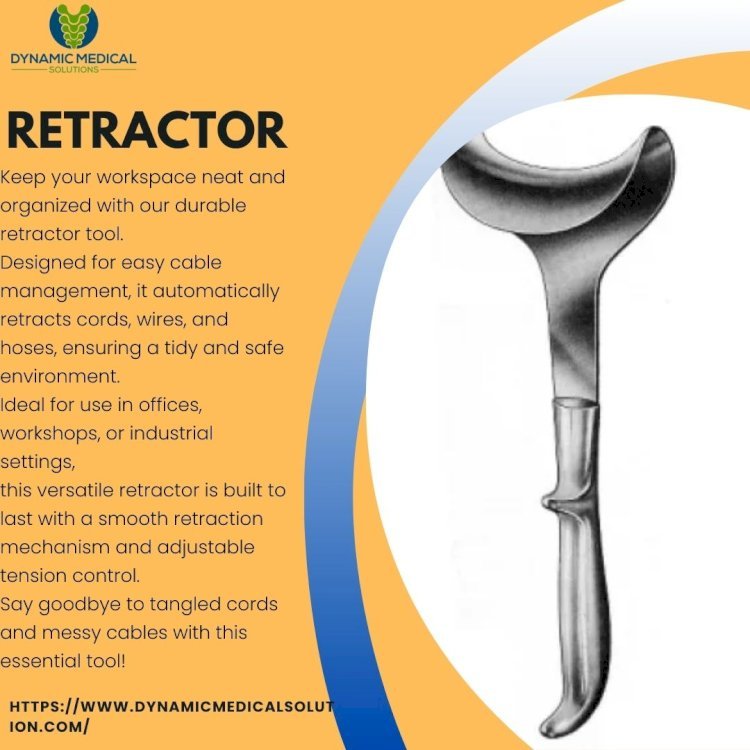Exploring the Types of Retractors Used in Surgery

A retractor is one of the most essential instruments in surgery, serving the critical role of holding back tissues, muscles, or organs to provide surgeons with a clear view of the operative site. These tools are indispensable in procedures ranging from simple incisions to complex surgeries. With various types of retractor instruments available, each is tailored to specific surgical needs, enhancing precision and reducing complications. Among them, the Mason Judd retractor stands out for its effectiveness in abdominal and deep-tissue surgeries. Let’s explore the different types of retractors and their applications in modern surgery.
Types of Retractors
The wide array of retractors is categorized based on their design, functionality, and the specific surgical procedures they are used for. The main types include handheld retractors and self-retaining retractors, each serving different purposes.
Handheld Retractors
Handheld retractors require a surgeon or assistant to manually hold them in place. They are highly flexible and can be easily repositioned during surgery. These retractors are commonly used in surgeries that require constant adjustments and mobility.
- Senn Retractor: This small, handheld retractor is often used in superficial surgeries, such as in skin incisions or small tissue manipulations. It has a dual end, with one side being a rake and the other flat, designed to retract delicate tissues.
- Army-Navy Retractor: A versatile retractor that is used in many general surgery procedures, especially in shallow areas. It is a simple instrument with two flat, curved blades at both ends, ideal for retracting muscle and soft tissues.
- Deaver Retractor: Commonly used in abdominal surgeries, this retractor has a long, thin, curved blade that is useful for deep retractions. It is an essential tool in thoracic and abdominal surgeries.
Self-Retaining Retractors
Self-retaining retractors can lock into place, allowing the surgeon to work without holding the instrument manually. These retractors are particularly useful in surgeries that require both hands free to operate.
- Weitlaner Retractor: This retractor is used primarily in orthopedic and spinal surgeries. It has a locking mechanism and pronged ends, making it ideal for holding back large tissues or muscles without the need for assistance.
- Balfour Retractor: Widely used in abdominal surgeries, this self-retaining retractor features a large frame that keeps the abdominal cavity open during long and complex procedures. Its multiple blades are adjustable to provide optimal visibility and access to deeper areas.
- Gelpi Retractor: Often used in orthopedic and neurosurgical procedures, the Gelpi retractor has sharp prongs that spread apart and lock into position, allowing for excellent retraction of tissues.
The Mason Judd Retractor: A Specialized Tool
One of the standout instruments in this field is the Mason Judd retractor. This particular retractor is highly valued in abdominal and pelvic surgeries due to its ability to provide superior exposure of the surgical area. It is specially designed to retract deep tissues, allowing surgeons to perform complex operations with better accuracy.
The Mason Judd retractor is known for its long, curved arms that hold back tissue layers efficiently while minimizing the risk of damage. Its stable design ensures that the retractor remains in place for the duration of the surgery, reducing the need for frequent adjustments and allowing the surgeon to focus on the procedure. This retractor is especially favored in gynecological and general surgeries where deep-tissue exposure is required.
Choosing the Right Retractor for Surgery
Selecting the appropriate retractor depends on the type of surgery being performed and the specific needs of the procedure. Handheld retractors are ideal for quick and dynamic adjustments, while self-retaining retractors are better suited for lengthy procedures where consistent tissue retraction is necessary. Specialized instruments, such as the Mason Judd retractor, provide additional benefits in surgeries that require deeper access and enhanced visibility.
The materials used to craft these instruments are also important, with modern retractors being made from stainless steel or titanium for durability, while some are coated for increased comfort and safety. The ergonomic design of today’s retractors helps reduce surgeon fatigue, making them more efficient in long, complex procedures.
Conclusion
The variety of retractor instruments available in surgery highlights their critical role in ensuring successful outcomes. From handheld to self-retaining retractors, each type serves a unique purpose in different surgical settings. The Mason Judd retractor remains one of the most specialized and effective instruments, particularly in abdominal surgeries, providing clear access to deeper tissues while reducing the risk of injury. As surgical techniques continue to evolve, so too will the design and functionality of retractors, ensuring that they remain integral to the future of medical procedures.For more info visit our website Dynamic medical.
What's Your Reaction?














